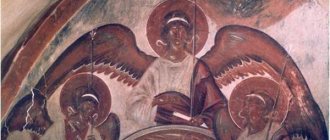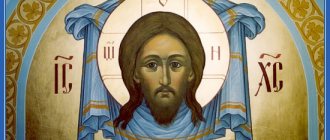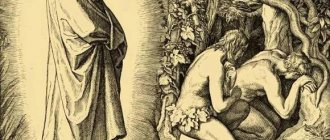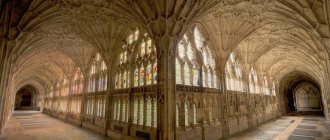Orthodox Life
Answered by teacher of the Kyiv Theological Academy Andrey Muzolf.
If we carefully read the Holy Scriptures of the Old Testament, we will see some inconsistency that seems at first glance. Thus, in the 26th verse of the 1st chapter of the Book of Genesis the following is said: “And God said: Let us make man in our image, after our likeness, and let them have dominion over the fish of the sea, and over the birds of the air, and over the livestock, and over over all the earth, and over every creeping thing that creeps on the earth.” But in the next verse, verse 27, something else is said: “And God created man in His own image, in the image of God He created him; male and female he created them.” Thus, we see that man was originally “planned” as the image and likeness of God, but as a result Adam was created only as the image of God. In this regard, many church critics pointed out the illogicality of the Bible and the presence of obvious errors and inconsistencies in it. Is it really?
The Holy Fathers, interpreting the above verses from the Book of Genesis, believed that there was no inconsistency or logical error in them at all. The concepts of “image” and “similarity” are related to each other as something static, that is, given to a person initially, and something dynamic, that is, something that a person himself is called to develop in himself. Thus, St. John of Damascus, Fr. In other words, “image” is a certain inclination of a person, those conditions thanks to which he can be directed towards deification, and likeness is nothing more than the process of deification or likening to God itself. At the same time, most of the holy fathers pointed out that the image of God is expressed in those properties of human nature that “make it related” to God, for example: intelligence, freedom, immortality and the ability to create. Saint Photius, Patriarch of Constantinople notes: “The fact that man arose in the image of God has occurred to some to be understood as rationality and free will, and to others as supremacy and the height of dominion, for in both cases a creature can reflect the Creator.” .
But at the same time, some theologians, such as, for example, in particular V.N. Lossky, believe that the image of God in its entirety is unknowable, for the reason that God Himself, as the Prototype, is by His nature unknowable to man . Vladimir Nikolaevich writes: “The image is unknowable, for, reflecting the completeness of its Prototype, it must also possess His unknowability. Therefore, we cannot determine what the image of God is in man.”
Based on all of the above, we can draw the following conclusion: despite the fact that each of us contains the image of God, which manifests itself in certain properties of human nature and which distinguishes man from the rest of creation, thereby bringing him closer to the Creator, but at the same time At the same time, the mere presence of the image of God will not bring us any benefit if we do not direct it in the right direction and do not strive for God-likeness, which, in fact, is the goal of our life.
Man is the image and likeness of God.
Vladimir Degtyarev,
The first chapter of the Bible, which describes the story of the creation of this world, presents information that attracts attention and that emphasizes the uniqueness of the human person.
When God begins to create man, he makes an important statement that captures the essence of the difference between man and everything previously created by God. He says: “Let Us make man in Our image, according to Our likeness” (Gen. 1:26-27). The words “image” and “likeness” are close in meaning and their meanings are almost indistinguishable. Both of these words are used solely to emphasize the greatness of the concept they describe. And they convey to us the idea of the mirror and reflection (2 Cor. 3:18), that is, the truth that man will be the reflection of God on earth. Therefore, speaking about the image of God in man, the following is meant: God created us in such a way that to some extent we are His reflection. Man was created by God in such a way as to, to some extent, reflect the glory of God himself.
The nature of God's image and likeness in man.
“According to the Bible, man is the crown of God’s creation and his glory is that he is created in the image of God and His likeness (Gen. 1:26-27). At one time, attempts were made to distinguish between the terms “image” and “likeness”. Some theologians have been of the opinion that the term "image" refers to the body, and the term "likeness" to the soul" (Louis Berkoff, Christian Doctrine, 96). A distinction is also sometimes made between the intellectual and moral image of God in man. The intellectual image includes such abilities as reason, memory and will. Moral image includes holiness, right relationship with God, and freedom from sinful tendencies.
It is often implied that after the Fall, the intellectual image remains more or less intact, while the moral image has been completely destroyed and can only be restored through the atonement in Christ. But, most likely, these terms are used simply as synonyms, reflecting the same essence, but from different angles (Gen.1:26,27; 5:1; 9:6; Jas.3:9; 1 Cor.11: 7). It may be more correct to say that the image of God is distorted in its entirety in fallen man, but that man still remains God's creation who bears the image of his Creator. Even after the complete moral and spiritual decay of humanity and, as a result, punishment by the flood, speaking of murder, God Himself reminds that “man was created in the image of God” (Gen. 9:6).
The importance of understanding that we are bearers of God's image and likeness.
We must always remember that the biblical truth that we are created in the “image and likeness of God” reminds us of the responsibility we have to be God’s authorized representatives on earth. It is likely that the likeness of God is manifested in us in the so-called communicable attributes of God, such as holiness, righteousness, mercy, love, joy, long-suffering, and so on. The more these qualities are manifested in a person’s life, the more he becomes like God. To a certain extent, an unbeliever also possesses such qualities to a certain extent, but they can and should fully manifest themselves in the life of a spiritually born person. This is what Scripture calls the fruit of the Spirit (Gal. 5:22-23; Eph. 5:9).
We can draw two important conclusions from the Biblical understanding of the image of God: first, God and man are not equal, but at the same time, God and man are not completely different. That is, between the eternal God and the finite and mortal man there is an infinite difference in strength, power, wisdom, holiness, love, and so on. Therefore, the difference between them, as someone said, is like an abyss in comparison with which the difference between the sun and a grain of sand is very small. However, there is something similar between God and man, just as there is something similar between the sun and a grain of sand. And, secondly, possessing the image of God, a person will never lose that high position in this world that God has endowed him with. This means that the image of God will forever be the distinctive sign of man from other living beings inhabiting our earth.
Vladimir Degtyarev,
Fundamentals of Christian Theology, Zaporozhye Bible College and (DMin Dissertation) Zaporozhye 2007
Conclusion
When God created plants and animals, He made them “according to their kind” (a phrase found ten times in Genesis 1:11-25). When He created Adam, He created him according to the race of God—in the image and likeness of God (Acts 17:28). After the Fall, man was created in the image (Genesis 9:6, 1 Corinthians 11:7) and likeness (James 3:9) of God. However, this image was desecrated by the rebellion of man during the Fall, and all aspects of the image of God were tarnished.
However, these aspects were perfected in the Lord Jesus Christ, who was and is “the image of the invisible God” (Colossians 1:15) and “the image of the hypostasis” of God (Hebrews 1:3), both on earth and in Heaven.
The Apostle Paul says that we are transformed or renewed into the image of God in the knowledge of Him and that this image is created “in true righteousness and holiness” (Colossians 3:10, Ephesians 4:24). This is not something that natural man can accomplish in his own strength, but it is the result of our “receiving Christ” in faith and repentance (John 1:12, Galatians 2:20). This is accomplished by the Holy Spirit (Titus 3:5, Romans 8:28-29), who has his dwelling place in the children of God (1 Corinthians 3:1, 6:19). “God is patient with us, not willing that any should perish, but that all should come to repentance” (2 Peter 3:9).
Divine Advice
In this intriguing verse, God appears to be talking to someone. Calvin said:
"It is the language of one who appears to be discussing... he is consulting."
Many other commenters call this "advice." But if this is so, with whom does God consult? And why? Does the Bible give any hint?
Since the Lord does not need another counselor, any such consultation had to take place in God - between God the Father, God the Son and God the Holy Spirit. Hebrews 1:2 in English says that when God created the world or the universe, he created it through his Son.
God could have easily created man with His own Word, as He did with animals (Genesis 1:20,24) and plants (Genesis 1:11), but He chose not to do so. Man is neither a close relative of animals nor a distant relative of primitive plant life. Rather, he is someone great, wonderful and different, the most excellent of all God's works, man is a special expression of the divine nature created by the personal activity of God. God creates it with the solemnity, dignity and honor of deep deliberation on the part of the Divine.
God endowed man with intellectual abilities that were and are far superior to those of any animal.
Although man was formed from the dust of the earth, God personally “breathed into his nostrils the breath of life, and man became a living being” (Genesis 2:7). Thus, man's life is not the result of a spontaneous reorganization of molecules within his body, nor was it caused by evolution from any animal or "lower hominid" (as theistic evolutionists claim), but is a direct gift from God. This is further emphasized in the Bible in the genealogy of Adam in Luke, where he calls Adam not the son of an anthropoid ape, but the “son of God” (Luke 3:38).
Why did God discuss this with the Son? Revelation 13:8 says that the Lamb of God (that is, Jesus) has been “slain from the foundation of the world.” By the sixth day of Creation Week, the foundation of the world was truly well laid, but with the creation of man, God was about to begin that chain of events that would inexorably lead to the future crucifixion and death of the Lord Jesus Christ on the Cross as atonement for the sin of mankind.
By His earthly life, Jesus confirmed His willingness to do the Father's will in this regard, in the Garden of Gethsemane (Matthew 26:39, 42). Is it possible that he also did this in the heavenly council just before God created Adam?
Chapter 5. Man
§ 1. Creation of man by God
Man was created on the sixth and final day of creation.
In the Book of Genesis, the creation of man is described as follows: “And God said: Let us make man in our image, after our likeness, and let them have dominion over the fish of the sea, and over the birds of the air, and over the beasts, and over the cattle, and over all the earth, and over all the reptiles that creep on the earth. And God created man in His own image, in the image of God He created him” (Genesis 1:26–27); “And the Lord God formed man of the dust of the ground, and breathed into his nostrils the breath of life, and man became a living being” (Genesis 2:7).
The peculiarity of man and his difference from other creations of God lies in the fact that he is a being in which the physical and spiritual are united.
The Monk John of Damascus speaks about it this way: “God created the spiritual essence, that is, the angels and all the heavenly ranks, for angels, without any doubt, have a spiritual and incorporeal nature... In addition, God created the sensory essence, that is, heaven, earth and what lies between them." Further in his reasoning, the Monk John conveys the words of St. Gregory the Theologian: “But there has not yet been a confusion of mind and feeling, a combination of opposites - this experience of the Highest Wisdom, this generosity in relation to both natures... Having wanted to show this, the Artistic Word creates a living being, in in which both are brought into unity, that is, the invisible and visible natures" 1 John of Damascus, St. An accurate exposition of the Orthodox faith. II. 12 (56); Gregory the Theologian, St. Word 38. 11..
Man, the microcosm (that is, the “small world”), became such a unity, “for he bears the image of the whole great world”2 Orthodox Confession of Faith of the Catholic and Apostolic Church of the East. Part I. Answer 18.. Saint Gregory of Nyssa says that “man is a certain small world, containing within himself the same elements with which the universe is filled”3 Gregory of Nyssa, St. About the soul and resurrection...
Man is the highest creation of God.
According to the holy martyr Irenaeus of Lyons, “the glory of God is a living man” 4 Irenaeus of Lyons, smch. Against heresies. IV. 20. 7.. The visible world, including the sky, earth, sea, sun, moon, stars, animals, plants, was formed before and for man. Saint Gregory of Nyssa describes the royal character of man in this way: “Man was introduced last into creation, not because he was rejected to the very end as unworthy, but because, together with the beginning of being, he had to become the king of the subordinates.” The saint compares God with a good host, who first cleans the house and prepares food, and then calls the distinguished guest: “In the same way, the rich and generous Master of our nature, having decorated this dwelling with all kinds of beauties, having prepared this great and well-stocked feast, then introduces the person , charging him with the task of not acquiring what does not yet exist, but enjoying what already exists.”5 Gregory of Nyssa, St. About the structure of man. 2..
Man was created to dominate the world around him.
Having created man, God gives him the power to give names: He brings to man all the animals and birds, “to see what he will call them, and that whatever man calls every living soul, that is its name. And the man gave names to all the livestock, and to the birds, and to every wild beast” (Genesis 2:19-20). Naming animals is a sign that God has placed man over them, made him their ruler. According to St. Gregory the Theologian, God places man on earth as “king over what is on earth.”6 Gregory the Theologian, St. Word 38. 11. .
The psalmist sings of the greatness of man: “When I look at Your heavens, the work of Your fingers, at the moon and the stars that You have set, what is man that You are mindful of him, and the son of man that You visit him? You have made him a little lower than the angels: You have crowned him with glory and honor; You have made him ruler over the works of Your hands; He put everything under his feet: the sheep and the oxen of all, and also the beasts of the field, the birds of the air and the fish of the sea, everything that passes along the paths of the sea” (Ps 8:4-9).
God created man as male and female.
The Holy Scripture says: “And God created man in His own image, in the image of God He created him; male and female he created them” (Gen. 1:27). Having created the first man, God created a helper for him: “And the Lord God said: It is not good for man to be alone; Let us make him a help suitable for him” (Gen. 2:18). God created man and woman equal in their human nature: Eve is “flesh of the flesh” of Adam (Gen. 2:23).
The belonging of each person to one of the two sexes - male or female - reveals the division in the one human nature, the reunification of which occurs in marriage through the union and communication of a man and a woman. The Lord Jesus Christ quotes the words of the Holy Scripture that God created man and woman, who are united “so that they are no longer two, but one flesh,” and then says: “Therefore, what God has joined together, let not man put asunder.” (Matthew 19:4–6).
§ 2. The image and likeness of God in man
Man, alone of all living beings, is created in the image and likeness of God.
Saint Gregory of Nyssa says: “What is important in this - to honor man as the image and likeness of the world, when heaven passes away, and the earth changes, and everything that is contained in them passes away? But what then, according to church teaching, is the greatness of man? Not in likeness to the created world, but in being in the image of the nature of the Creator.”7 Gregory of Nyssa, St. About the structure of man. 16..
The Holy Fathers distinguish between the “image” and “likeness” of God in man. The image of God was given to man at the moment of his creation. Likeness to God must be achieved by man through moral improvement and good deeds8 Irenaeus of Lyon, smch. Against heresies V. 6. 1; Clement of Alexandria. Stromata. II. 22; Origen. About the beginnings. III. 6. 1; Diadochos of Photicus, Blessed. The word is ascetic. 89; Maxim the Confessor, St. Chapters about love. 3.25; John of Damascus, St. An accurate exposition of the Orthodox faith. II. 12.. Saint Basil the Great says that man is a creature who has received the command to become god9 These words of Saint Basil are quoted by Saint Gregory the Theologian: Gregory the Theologian, St. Word 43.
Having created man in His image, God made him a participant in the blessings and perfections that only He Himself fully possesses: God creates man “not deprived of blessings”; and “since the detailed list of blessings is large and it is impossible to count them, God’s word, in a brief saying, united all the blessings, designated them, saying that man was created in the image of God. For this means the same as saying: man was created by nature as a participant in all good.”10 Gregory of Nyssa, St. About the structure of man. 16..
The image of God, given to man from birth, is indestructible, but the likeness can be lost as a result of a sinful life.
The image of God in man has various features.
The Holy Fathers talk about different features of the image of God in man. The conformity of man to God is seen in the royal dignity of man, in his superiority over the entire created world. Godlikeness is indicated by the spiritual nature of man: the soul as an immaterial part of man11 Gregory the Theologian, St. Word 8; Maxim the Confessor, St. Chapters on theology and the economy of the incarnation of the Son of God. 1. 11; Maxim the Confessor, St. Mystagogies. 6., reason as its highest ability12 John of Damascus, St. An accurate exposition of the Orthodox faith. III. 18.. The image of God, according to the fathers, also consists in the freedom given to man, in his ability to create. 13 According to Basil of Seleucia, by giving man the right to name animals, God seems to be saying to Adam: “Be the creator of names, since you cannot be the creator of the creatures themselves... We share with you the glory of creative wisdom... Give names to those to whom I gave being" (Basily of Seleucia. A Word about Adam)..
At the same time, it is impossible to fully comprehend the meaning of the creation of man in the image of God. “Since one of the properties seen in God’s nature is the incomprehensibility of the essence, then, by all necessity, the image in this has a resemblance to the Prototype”14 Gregory of Nyssa, St. About the structure of man. 11., says Saint Gregory of Nyssa.
The concept of human dignity is associated with the image of God in man.
Each person, as a bearer of the image of God, has dignity and worth. Saint Gregory the Theologian says: “God has so generously endowed all people, of course, in order to show by the equal distribution of His gifts both the equal dignity of our nature and the wealth of His goodness.”15 Gregory the Theologian, St. Word 14..
The basis of the Christian attitude towards man is the commandment to love one's neighbor. more details: Fundamentals of Orthodox moral teaching. Chapter 1. § 3–4.
. To fulfill this commandment, first of all, you need to see the image of God in every person. Holy Righteous John of Kronstadt says: “Love every person, despite his fall into sin. Sins are sins, but the basis in man is one - the image of God."17 John of Kronstadt, St. right My life in Christ. 267..
High human dignity must also be matched by a life appropriate to it: “If the image of God in Orthodoxy is elevated to the inalienable, ontological18 Ontological - relating to the very existence of man. the dignity of each human person, its highest value, then a life befitting dignity is correlated with the concept of the likeness of God, which, by Divine grace, is achieved through overcoming sin, acquiring moral purity and virtues"19Fundamentals of the teaching of the Russian Orthodox Church on dignity, freedom and human rights. I. 2..
§ 3. Human structure
Man is a rational living being, consisting of a soul and a body.
The Holy Fathers speak of man as a mental-physical being. Martyr Justin the Philosopher writes: “Is the soul itself a man? No, not a soul man. Can you call the body a person? No, but it is called the human body. So, neither of the two in itself is a person, but the combination of both is called a person.”20 Justin the Philosopher, martyr. About the resurrection. 8.. And the Hieromartyr Irenaeus of Lyons teaches: “The perfect man is the union and union of the soul, which receives the Spirit of the Father, with the flesh.”21Irenaeus of Lyons, smch. Against heresies. V 6. 1.. According to the Venerable Simeon the New Theologian, man is “a living being, mortal and immortal, visible and invisible, sensory and mental, capable of seeing the visible creation and comprehending the mental”22 Simeon the New Theologian, Venerable. The chapters are theological, speculative and practical. 2. 23..
The Fathers of the Church, distinguishing in man the material principle, called “body” or “flesh”, and the spiritual, expressed by the words “soul” and “spirit” (or “mind”), speak primarily about the two-part composition of man (body and soul), and sometimes - about the tripartite (body - soul - mind or body - soul - spirit). At the same time, the mind, or spirit, is understood as the highest ability of the soul23Augustine of Ippon, Blessed. About the symbol of faith. X. 23; John of Damascus, St. An accurate exposition of the Orthodox faith. I. 13..
The human body is structured wisely and proportionately, each organ in it performs a specific function.
About the rational structure of the human body, the Apostle Paul says: “There are many members, but one body... But God proportioned the body, giving greater care to the less perfect, so that there would be no division in the body, but all members would equally care for each other” (1 Cor 12:20 ; 24–25).
The human body is designed in such a way as to be an exponent of his spiritual abilities and properties. Drawing attention to the significance of the body in human life, to its wise structure, the holy fathers cited, to express its relationship to the soul, a comparison with a dwelling for a tenant, with a brush for an artist.24 Justin the Philosopher, martyr. About the resurrection. 10; Irenaeus of Lyon, sschmch. Against heresies V. 3. 3.. “We do nothing without the body. We blaspheme with our lips and pray with our lips, we commit fornication with our bodies and keep our bodies pure; we steal with our hands and give alms with our hands.”25 Cyril of Jerusalem, St. The teachings are public. XVIII. 19..
A person should not despise his body. The Apostle Paul says: “No one has ever hated his own flesh, but rather nourishes and cherishes it...” (Eph 5:29). Man will be resurrected in the body: “May the God of peace himself sanctify you completely, and may your spirit and soul and body be preserved blameless at the coming of our Lord Jesus Christ” (1 Thessalonians 5:23).
Saint John Chrysostom refutes the opinion of heretics who claim that the body was not created by God, since the human body is imperfect, and God could not create imperfections. About statues. 11.2..
A person’s care for his body should include protecting the body from sin, for the human body is the property of God: “Do you not know that you are the temple of God?” (1 Cor 3:16); “Do you not know that your bodies are members of Christ?” (1 Cor 6:15).
The soul is one of the two principles in a person, distinguished from the body.
In the patristic teaching, the soul is defined as a living essence, simple and incorporeal, by its nature invisible to bodily eyes, endowed with reason, without a specific form; she acts with the help of the body as an instrument and imparts life, growth, feeling to it. 27 John of Damascus, St. An accurate exposition of the Orthodox faith. II. 12..
The soul in man is the highest principle, and the body is the lowest. The body in relation to the soul must be in hierarchical subordination: “The soul owns and controls the body,” says Hieromartyr Irenaeus of Lyons. He compares the soul with an artist, and the body with the instrument with which he creates. Against heresies. II. 33. 4.. Tertullian calls the body the servant of the soul29Tertullian. About the soul. 40..
The highest part of the soul is called “spirit” or “mind”.
Blessed Augustine says that “spirit” is the rational part of the soul, which animals do not have.30 Augustine of Hippo, Blessed. About the symbol of faith. X. 23.. St. John of Damascus identifies “spirit” and “mind,” referring them to the highest part of the soul31John of Damascus, Ven. An accurate exposition of the Orthodox faith. I. 13.. He states that “the mind belongs to the soul not as something else distinct from it, but as the purest part of itself”32 Ibid. II. 12.. The mind has the ability to contemplate the spiritual world: “As the eye is in the body, so is the mind in the soul”33John of Damascus, St. An accurate exposition of the Orthodox faith. II. 12..
The Monk Maximus the Confessor speaks about various states of mind: “The mind directed to God by prayer and love becomes wise, strong, humane, merciful, or, simply put, has in itself all the properties of God, but when moving to material things, it becomes animal and rude.” »34 Maxim the Confessor, St. Chapters about love. II 52..
The center of a person's spiritual life is the heart.
In this case, the “heart” does not mean a physical organ, but the center of a person’s spiritual and emotional life. “Blessed are the pure in heart, for they will see God,” says the Lord (Matthew 5:8). At the same time, according to the Savior, evil thoughts, murder, adultery, fornication, theft, false witness, blasphemy, arise in the heart and from it proceed (Matthew 15:19). Therefore, the task of ascetic efforts is 35Fundamentals of Orthodox moral teaching. Chapter 3. § 1. - cleanse the heart, free it from sinful aspirations.
According to the patristic teaching on unceasing prayer36 See: Fundamentals of Orthodox moral teaching. Chapter 4. § 3., an ascetic who wants to remain in this prayer must bring his mind into his heart in order to keep it in constant memory of God37 See. for example: Gregory of Sinai, St. On silence and two types of prayer; Nicephorus the Solitary, St. The word about sobriety and guarding the heart is very useful..
§ 4. The state of primordial man
Primordial man was in complete harmony with God and the world around him.
“God,” writes the Monk John of Damascus, “created man immaculate, upright, loving goodness, free from sorrow and worries, adorned with all virtue, abounding in all blessings... He created him sinless by nature and free of will... not because he is not was susceptible to sin - for only the Divine is not susceptible to sin - but because the possibility of sin lay not in his nature, but rather in his free will. This means that, with the assistance of Divine grace, he had the opportunity to remain and succeed in goodness, and equally, by virtue of his freedom, with God’s permission, to leave goodness and find himself in evil, for what is done under compulsion is not virtue »38 John of Damascus, St. An accurate exposition of the Orthodox faith. II. 12..
Adam was a “friend of God”: “The angels trembled, the cherubim and seraphim did not dare to look directly at God, while Adam talked with Him as if with a friend.”39 John Chrysostom, St. Conversation 3: In the Temple of the Apostle Thomas..
Having created man, God placed him in the Garden of Eden, which is also called paradise.
The Holy Scripture says: “And the Lord God planted a garden in Eden in the east, and there he placed the man whom he had created. And the Lord God made out of the ground every tree that was pleasant to the sight and good for food, and the tree of life in the midst of the garden, and the tree of the knowledge of good and evil... And the Lord God took the man [whom he had created] and put him in the garden of Eden to cultivate it and keep it” (Genesis 2:8–9, 15).
Among the other trees planted by God in the Garden of Eden, two are especially mentioned - the tree of life and the tree of the knowledge of good and evil.
About the tree of life, Blessed Augustine writes the following: “Although this tree represented bodily food, it was food that made the human body constantly healthy, not as from any other food, but due to some hidden inspiration of health.”40 Augustine of Ipponia, Blessed. About the Book of Genesis literally. 8. 5.. Human nature in itself did not possess immortality, since human life was supported by Divine grace. St. John of Damascus says that “according to the laws of created nature, everything created is subject to corruption, but is held together and preserved by God’s grace.”41 John of Damascus, Ven. An accurate exposition of the Orthodox faith. II. 6.. According to the words of St. Athanasius the Great, “man, as created from nothing, is mortal by nature; but, due to the similarity to the Existing One... he could slow down the natural corruption in himself, and would remain incorruptible”42 Athanasius the Great, St. About the incarnation of the Word. 14..
The first commandment given to man by God is associated with the tree of the knowledge of good and evil. The Holy Scripture says: “And the Lord God commanded the man, saying, Of every tree of the garden thou shalt eat, but of the tree of the knowledge of good and evil thou shalt not eat of it, for in the day that thou eatest of it thou shalt surely die” ( Gen 2:16–17). The commandment of God was not just a prohibition, it indicated that man depends on God, who gave him life and called man to communicate with Him.
§ 5. Fall
The first man, Adam, transgressed the commandment given to him by God and thereby committed the Fall. 43The Fall of Adam in theological literature is sometimes called “original sin,” that is, the first, original sin, followed by all other sins. .
Adam broke the commandment given to him by God not to eat the fruit of the tree of the knowledge of good and evil, being tempted by the devil, who appeared to him in the form of a serpent (Genesis 3:1). According to St. John Chrysostom, “the evil demon and enemy of our race, when he saw that the first-created one was spending a carefree life in paradise and, clothed in flesh, living on earth like an angel, decided to seduce and entice him to fall with the promise of even greater benefits, and so thus deprived him of what he already possessed”44John Chrysostom, St. Conversations on the Book of Genesis. 12..
The Holy Scripture describes the crime of the first people as follows: “The serpent was more cunning than all the beasts of the field that the Lord God created. And the serpent said to the woman: Did God truly say: You shall not eat from any tree in the garden? And the woman said to the serpent: We can eat fruit from the trees, only from the fruit of the tree that is in the middle of the garden, God said, do not eat it or touch it, lest you die. And the serpent said to the woman: No, you will not die, but God knows that on the day that you eat of them, your eyes will be opened, and you will be like gods, knowing good and evil. And the wife saw that the tree was good for food and that it was pleasant to the eyes and desirable because it gave knowledge; and she took of its fruit and ate; And she gave it also to her husband, and he ate” (Genesis 3:1–6).
The devil tempted man with the false hope that man could become equal to God (Genesis 3:5). The reason that a person succumbed to this temptation was unbridled pride: “We should not think,” says Blessed Augustine, “that the tempter would have succeeded in seducing a person, even if in the soul of this latter there was not some exaltation that needed to be curbed.”45Augustine Ipponsky, blessed one. About the Book of Genesis literally. 11.5..
Instead of admitting guilt and repenting of what they had done, Adam and Eve tried to justify themselves: “Adam said: the wife whom You gave me, she gave me from the tree, and I ate. And the Lord God said to the woman: Why have you done this? The woman said, “The serpent deceived me, and I ate” (Genesis 3:12-13).
As a result of the Fall, man became mortal.
Having transgressed the commandment, man separated himself from God, Who supported him in a state of immortality, and found himself doomed to death: “People, having deviated from the eternal and, on the advice of the devil, turned to the corruptible, for themselves became the culprits of corruption and death; because... by nature they were corruptible, but what was inherent in their nature would have been avoided by grace... natural corruption would not have approached them. in them"47 Athanasius the Great, St. About the incarnation of the Word. 1. 5.. Bodily decay brought with it illness, suffering, aging and, ultimately, death as the separation of soul and body.
God says to Eve: “I will multiply your sorrow in your pregnancy; in illness you will give birth to children; and your desire will be for your husband, and he will rule over you” (Genesis 3:16). To Adam God says: “By the sweat of your face you will eat bread until you return to the ground from which you were taken; For you are dust, and to dust you will return” (Gen. 3:19).
The consequences of the Fall from one person spread to the entire human race.
“Just as through one man sin entered into the world, and death through sin, so death spread to all men,” says the Apostle Paul (Rom 5:12). Adam's sin, according to St. John Chrysostom, became the cause of “general damage” to human nature48John Chrysostom, St. Discourses on the Epistle to the Romans. 10. 1.. As St. Cyril of Alexandria writes, “nature was infected with the disease of sin through the disobedience of one, that is, Adam. Therefore, the multitude [of people] became sinful; not because it shared Adam’s sin—it did not yet exist—but because it shared with him his nature, which was subject to the law of sin.”49 Cyril of Alexandria, St. Commentary on the Epistle to the Romans. 5. 18..
Being a descendant of Adam and having inherited his nature, every person is involved in sin from the very moment of his birth: “We are all (born) from Adam who sinned as sinners, from a criminal - criminals, from a slave of sin - slaves of sin, from the damned and dead - cursed and dead; from one who gave consent to the devil, became enslaved to him and lost his free will - and we are his children, over whom the devil tyrannically rules and dominates.”50 Simeon the New Theologian, St. Catechetical words. 5.406–413..
Damage to human nature has made man prone to sin, as evidenced by the Apostle Paul: “I know that nothing good lives in me, that is, in my flesh; because the desire for good is in me, but I don’t find it to do it. I don’t do the good that I want, but I do the evil that I don’t want. If I do what I do not want, it is no longer I who do it, but sin living in me. Therefore I find it a law, that when I would do good, evil is present with me” (Rom 7:18-21). Saint Gregory the Theologian speaks about this duality of fallen man: “I have two minds: one is good, and he follows everything that is beautiful, and the other is worse, and he follows evil; one mind moves towards the light and is ready to submit to Christ, and the other - the mind of flesh and blood - is drawn into darkness and agrees to surrender into captivity to Belial."51 Gregory the Theologian, St. Poems about yourself. 45. Belial - devil; see for more details: Chapter 4. § 3..
The consequences of the Fall spread not only to people, but also to the entire created world.
“Cursed is the ground because of you,” God says to Adam (Gen. 3:17). Called to be the crown of creation, the ruler of the created world, man fell from the height of his calling. According to St. John Chrysostom, “since [man] received a mortal body and subject to suffering, the earth was cursed and produced thorns and thistles”52 John Chrysostom, St. Discourses on the Epistle to the Romans. 14..
The Apostle Paul says that the whole creation “has not voluntarily submitted itself to vanity,” it “groans and is tormented together until now,” but with “hope awaits” liberation “from the bondage of corruption” and “not only it, but we ourselves, having the firstfruits of the Spirit, and we groan within ourselves, waiting for adoption as sons, the redemption of our body” (Rom 8:19-23).
Overcoming the consequences of the Fall for humanity and the entire created world is accomplished by the God-man Jesus Christ - the second Adam53See: Chapter 6. § 3..
Chapter 4. Peace
Table of contents
Chapter 6. Christ
On the last day of creation, God said, “Let us make man in our image, according to our likeness” (Genesis 1:26). Thus He completed His work with a “personal signature.” God formed man from dust and gave him life by sharing His own breath (Genesis 2:7). In this regard, man is unique among all God's creations, having both material (body) and immaterial (soul/spirit) components.
To be the “image” or “likeness” of God in the simplest terms means that we were created to be like God. Adam was not like God in the sense that God has body and blood. Scripture says that “God is spirit” (John 4:24) and thus exists without a body. However, Adam's body reflected the life of God in that it was in perfect health and was not subject to death.
The image of God refers to the immaterial part of man. This sets man apart from the animal kingdom, preparing him for the dominion God intended (Genesis 1:28), and enabling him to maintain a relationship with his Creator. This similarity is mental, moral and social.
Mental similarity - because man was created as a rational, strong-willed person, in other words - man can reason and can choose. This is a reflection of God's intelligence and freedom. Every time someone invents a car, writes a book, paints a landscape, enjoys a symphony, calculates a sum, or names a pet, they are affirming the fact that we were created in the image of God.
Moral Similarity – Man was created in righteousness and spotless innocence, reflecting God's holiness. God saw everything He did (including mankind) and said it was “very good” (Genesis 1:31). Our conscience, or “moral compass,” is a trace of that initial state. When one writes a law, renounces evil, praises good behavior, or feels guilty, he is affirming the fact that we were created in the likeness of God himself.
The similarity is social - man was created for communication. This reflects the Divine triune nature and His love. In Eden, man's first relationship was with God (Genesis 3:8 suggests fellowship with God), and God created the first woman because “it was not good for man to be alone” (Genesis 2:18). Every time someone gets married, dates someone, hugs a child, or attends church, they demonstrate the fact of our creation in the image of God.
Being created in God's image, Adam also had the ability to make free choices. Although he was given a righteous nature, Adam made the wrong choice to rebel against his Creator. By doing this, he distorted God's image in himself, and he passed this on to all his children, including us (Romans 5:12). Today we still bear the image of God (James 3:9), but we also bear the scars of sin. This manifests itself mentally, morally, socially and physically.
The good news is that when God redeems a person, He begins to recreate His original image, creating “…a new man, created according to God in true righteousness and holiness” (Ephesians 4:24; see also Colossians 3:10).
SECTION II. ORTHODOX TEACHING ABOUT MAN
Holy Scripture says that with the creation of Adam, and in his person and human nature as such, the creative action of God in relation to man does not end. The Book of Genesis emphasizes: And God created man... male and female he created them.
(Gen.1:27).
In the first part of the phrase, the word man
is used in the singular, and in the second part the plural appears:
created them
.
According to the 1st chapter of the Book of Genesis, man represents two human hypostases that exist in the unity of nature. Chapter 2 explores this idea in more detail. One should not, however, assume that the writer of everyday life tried in the 2nd chapter of Genesis to explain the appearance of the wife in a biological sense. This is, first of all, a symbolic narrative, which in a visual form expresses the idea of the dual unity of man.
In connection with this biblical narrative, a very important question for the Orthodox teaching about man is connected - about marriage and the divinely established method of reproducing people. In patristic literature there is sometimes an opinion that after the Fall there is a change in the very method of human reproduction. Yes, holy. Gregory of Nyssa writes: “[After the Fall, God] arranges in nature a method of reproduction that corresponds to those who have slipped into sin, instead of the angelic nobility of that, implanting in humanity a bestial and dumb method of mutual succession.”706. True, holy. Gregory of Nyssa stipulates that this is his personal opinion and guess. According to the assumption of St. John Chrysostom, if there had been no Fall, people would have multiplied in some spiritual way, but the saint does not specify how he imagines this707. This opinion was also shared by Bla. Theodoret of Cyrrhus708, Rev. John of Damascus709 and some other Byzantine theologians.
Of course, after the Fall, the way of being of human nature changed. This applies to both mental and biological life of a person. In this sense, we can talk about a change in the method of reproduction, but only to the extent that the way of human existence in general has changed. The idea that, as a punishment, God condemns a person to a special, “bestial” way of reproduction instead of the one that was before, would mean that human nature as such has changed, and not just its state, which does not fit well with other aspects of Orthodox Christianity. anthropology and soteriology. This is probably why this opinion is not widespread.
Did marriage exist before the Fall, in paradise? The answer to this question depends on how exactly the concept of “marriage” is defined. If we consider marriage in the categories of Roman law, as a contract, as a utilitarian procreative institution, then we can say that there was no place in heaven for such a marriage. Holy John Chrysostom says: “The Primordial One lived in paradise, but there was no talk of marriage. He needed an assistant - and he appeared; and yet marriage did not yet seem necessary.”710
All of God's creation is “very good.” But after God, completing the creation of the world, creates the highest being, the crown of creation - man, He states that it is insufficient for him to exist outside of communication with another person and says: it is not good for man to be alone, let us create for him a helper corresponding to him
(Gen.2:18).
Therefore, we can say that the opinion of some Church Fathers, in particular, is holy. Gregory of Nyssa, that the division of people into two sexes was carried out by God solely in anticipation of the Fall711, does not have sufficient basis in the Holy Scriptures. The division of man into two sexes was made, first of all, in order to satisfy the human need for communication. God brings a wife to Adam, and he says: Behold, this is bone of my bones and flesh of my flesh
(Gen. 2:23). These words speak of the unity of nature of a man and a woman and, most of all, encourage mutual love and care for each other. According to X. Yannaras, “the difference between the sexes is due to the need to express within the framework of created nature the way of life of the uncreated”712. And the life of the Most Holy Trinity is not simply unity at the level of nature, but the union in love of original and distinct Hypostases.
The Synodal Translation of the Old Testament, as well as the Septuagint, speaks of the wife as a “helper” (Greek: βοηθός), who was created for the husband. However, this word does not fully convey the meaning of the Hebrew word ʽēzeѴ4; (ezer)
. Prof. S. V. Troitsky in the book “Christian Philosophy of Marriage” writes: “Here we are not talking about replenishment in work, but about replenishment in being itself, so that help in work can only be thought of as a consequence of replenishment in being. First of all, the husband needs a wife as his “alterego” [second “I”]713. Thus, the biblical narrative reveals the truth about the dual unity of man, realized in the marriage union of a husband and wife united by love.
Why does the Bible say that the wife was created precisely “from the rib” of Adam? This may be due to the fact that the Hebrew word ṣēlāʽ (whole)
, in addition to meaning “edge,” can also mean “side, side.” Thus, this image helps to reveal the idea that human nature is divided into two complementary parts.
It follows from the Holy Scriptures that the essence of marriage does not change after the Fall. A man will leave his father and mother and cleave to his wife; and the two shall become one flesh
(Gen.2:24).
In the Book of Genesis these words are spoken by Adam. However, there is no doubt that they were uttered by Adam not on his own, but by inspiration from above, because otherwise the Lord Jesus Christ would not have brought them during His earthly life: ... and the two will become one flesh, so that they are no longer two, but one flesh
(Matt. 19:5–6). Thus, before and after the Fall, Scripture speaks of marriage in the same terms.
It should be noted that the Greek word used in these fragments is σάρξ (flesh) and its corresponding Hebrew bāśāѴ4; (basar)
means “flesh, body, meat”, and the expression
kV1;l-bāśāV4;
– “the entire human race” or “every living thing” (Gen.6:3; Ps.55:5). Thus, the above words do not refer to a temporary physical union of the parties, but to the permanent unity of all aspects of the life of the spouses.
The true attitude of the Church towards marriage was expressed in the decrees of the Gangra Council (IV century), which ordered the defrocking of clergy and excommunication from the Church of laity who abhor marriage, that is, those who refuse married life not for the sake of heroic deeds, but because considers marriage to be something unworthy of a Christian (rules 1, 4, 13)714. Indeed, if marriage in itself implied something sinful, then in this case the words of St. Paul, who likened the unity of Christ and the Church to a marriage union, would sound blasphemous. Among the saints canonized by the Church, there are many people who were married.
The Church elevated marriage to the level of a church sacrament, placing marriage on a par with such sacred rites as baptism, confirmation, priesthood, etc.
Holy Gregory the Theologian, the greatest ascetic and mystic, in the poem “Praise of Virginity,” where he aims to prove the advantage of a virgin lifestyle over marriage, nevertheless writes about marriage with great respect: “Look what a prudent marriage has brought to people. Who taught the coveted wisdom? Who discovered the depths that the earth, the sea, and the sky contained within themselves? Who gave laws to cities, and even before this, who erected cities and invented arts? Who filled the marketplaces, houses and lists?.. Who gathered a singing crowd in the fragrant temple? Who else but marriage? Who besides him has united the most distant things between them?.. Being one flesh, spouses have one soul, and through mutual love they equally arouse in each other zeal for piety. Marriage does not remove you from God, but on the contrary, it binds you more closely to Him.”715
These words especially emphasize that the improvement of relations between the sexes in marriage determines all the positive achievements of culture. And, most importantly, marriage is sacred. Gregory, is not a distance from God, but a sacrament of His love.
Tertullian, in a work called “To a Wife,” writes: “How pleasant it must be to unite two hearts in the same hope, service and faith! Verily, they are two in one flesh: where there is one flesh, there is one spirit. They pray together, kneel together, fast together, mutually approve and support each other. They are equal in the Church of God and at God’s table, equally share persecution and rest, do not hide anything from each other, are not burdened by each other... The Lord rejoices, seeing their unanimity, sends peace to their home and remains with them.”716. In the Holy Scriptures, God's relationship with Israel is very often expressed through the image of the relationship between husband and wife, groom and bride. And for Christian ascetic literature, for example for such authors as Rev. John Climacus717, Rev. Neil of Sinai718, it is typical to talk about man’s love for God through images and analogies borrowed from relations between the sexes.
The main goal of a person’s life is to hear the call of God addressed to him and answer it. But in order to answer this call, a person must be able to commit an act of self-denial, reject his own “I”, his egoism. Christian marriage serves this purpose, and that is why Christian marriage does not remove a person from God, but brings him closer to Him. Marriage is viewed in Christianity as a joint journey of spouses into the Kingdom of God. X. Yannaras reveals this idea as follows: “Only when eros, directed at a person of the other sex, leads to love, to a person’s oblivion of himself, his individualism... only then does the opportunity open up for a person to respond to the call of God addressed to him... That is why the image conjugal love is an image of the love of Christ and the Church on the cross, the voluntary mortification of natural limitations and individuality so that life can be realized as love and self-giving.”719
But Christianity, which highly values marriage, at the same time frees a person from the need for married life. From a Christian point of view, in order to realize one's life as one of love and fellowship, marriage is not strictly necessary. There is an alternative path to the Kingdom of God - virginity, monasticism. This is a rejection of natural self-denial in love, which is marriage, and the choice of a more radical path of self-denial through obedience and asceticism, in which the only source of existence for a person becomes the call of God addressed to him. Both of these paths in Christianity are equally recognized and revered as leading to a common goal.
In the Christian teaching about man, the ontological dignity of a woman is restored and justified, which was not the case in pagan religions and which was only declared in the Old Testament. Clement of Alexandria writes: “Virtue... ought to be the concern of both husbands and wives alike. Because if they both have the same God, then it means that both of them... have one church; This means that the same law of measure exists for them, the same natural shame, the same food, the same marriage relations... the same reasoning, hope, Christian love... But if all the conditions of life are common for them, then they participate equally ... and in grace, the path of salvation is the same for them, Christian love is equally valuable for them; and therefore they are subject to the same education by the Logos... The reward for a holy, compassionate life here on earth is promised not to a husband or wife, but to a person in general...”720 From the point of view of soteriology, differences based on gender do not have any significant meaning. As Procopius of Gaza writes, “...neither husband without wife, nor wife without husband in the Lord. If they differ in body, then in the soul, which is both immortal and rational, the feminine nature is no different from the masculine.”721. According to St. Basil the Great: “A wife, along with her husband, has the honor of being created in the image of God. The nature of both is equal.”722
In the image of God
When God created man in his own image, he determined that humanity (both male and female) would have certain similarities to God and share certain divine prerogatives. Regarding this we note:
It wasn't a physical resemblance, but...
Although God is spirit (John 4:24) and does not have a body like man, when He manifestly appeared to men under the Old Testament, He did so in the form of a human body (for example, Genesis 18:1-2, 32: 24, 28, 30). Dr. Henry Morris writes:
“Therefore, there is something in the human body that is uniquely suited to manifest God, and (since God knows all His works from the very beginning of the world - Acts 15:18) He must have designed the human body with this in mind. Accordingly, He created him not like animals, but in an upright position, with his gaze directed upward, with a face capable of expressing emotional feelings, and with a mind and tongue capable of symbolic speech.",
Moreover, the human body was created in the form in which God the Son would be incarnate, or “created in the likeness of men” (Philippians 2:7). Thus, God created man in the bodily form that He Himself would one day assume—the form in which He wanted to reveal Himself.
It was a mental similarity
God endowed man with intellectual abilities that were and are far superior to those of any animal. Thus, man was given a mind to hear and understand God's communication with him, an emotion to respond to God with love and devotion, and a will that allowed him to choose whether to obey or disobey Him. Thus man was formed not only to “love God and obey Him always,” but also to do God’s work on earth—to be a member of His council and to govern creation in cooperation with his Creator.
This is seen in God's command to Adam and Eve to exercise dominion over the earth and its animals (Genesis 1:26,28), in Adam's task to perfect the garden (Genesis 2:15), and in Adam's command to name the animals of the earth (Genesis 2:19 -20).
Man's intellectual gifts are also seen in his ability to design things and then create them, appreciate beauty, compose glorious music, paint pictures, write, calculate large numbers and solve mathematical problems, control and use energy for his own needs (e.g. fire, electricity, nuclear energy), organize, reason, make decisions, be conscious, laugh at yourself and think abstractly. All this behavior is not instinctive, unlike the behavior of animals, and therefore it has unlimited variety.
It was a moral semblance
Only man, of all God's creatures, has the spirit or understanding of God, that is, the ability to know Him and maintain spiritual communication with Him through prayer, praise and worship. Since the Fall (Genesis 3), man has had an innate moral awareness of good and evil, or a conscience, which he feels in his spirit.
Man was created not only innocent (that is, without sin), but also holy, otherwise Adam could not have fellowship with God, who cannot look upon iniquity (Habakkuk 1:13). This is confirmed in Genesis 1:31 when God states that everything He did (including man) was “very good,” which would not be true if man were morally flawed.
It was social similarity14
God's social nature and inner love are seen in the doctrine of the Trinity. God - Who is love - created man with a social nature and a need for love. Genesis 3:8 says that “they heard the voice of the Lord God walking in the garden in the cool of the day.” This suggests that Adam and Eve enjoyed company and fellowship with God, perhaps on a daily basis.
God also provided human companionship and love in a special and intimate way. Before He created Eve, He said, “It is not good for man to be alone; I will make him a helper suitable for him” (Genesis 2:18). He then created Eve from a rib taken from Adam (Genesis 2:21-24), a fact that Jesus used in his discussions with the Pharisees to defend the sanctity of marriage and the intimacy of love in the marital relationship (Matthew 19:4-6, Mark 10:6-8).











